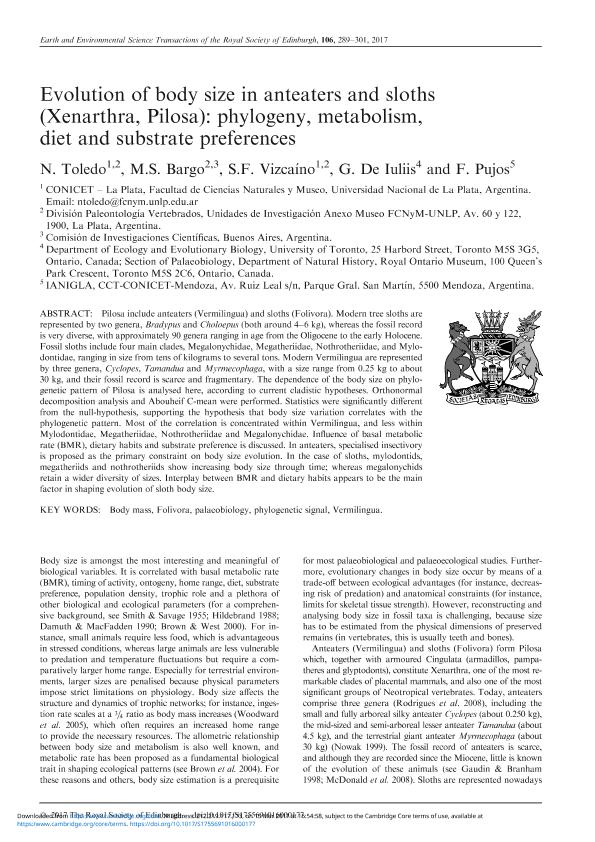Mostrar el registro sencillo del ítem
dc.contributor.author
Toledo, Néstor

dc.contributor.author
Bargo, María Susana

dc.contributor.author
Vizcaíno, Sergio Fabián

dc.contributor.author
De Iuliis, G.
dc.contributor.author
Pujos, François Roger Francis

dc.date.available
2018-08-21T19:05:58Z
dc.date.issued
2017-02
dc.identifier.citation
Toledo, Néstor; Bargo, María Susana; Vizcaíno, Sergio Fabián; De Iuliis, G.; Pujos, François Roger Francis; Evolution of body size in anteaters and sloths (Xenarthra, Pilosa): Phylogeny, metabolism, diet and substrate preferences; Royal Society of Edinburgh; Earth and Environmental Science Transactions of the Royal Society of Edinburgh; 106; 4; 2-2017; 289-301
dc.identifier.issn
1755-6910
dc.identifier.uri
http://hdl.handle.net/11336/56403
dc.description.abstract
Pilosa include anteaters (Vermilingua) and sloths (Folivora). Modern tree sloths are represented by two genera, Bradypus and Choloepus (both around 4-6 kg), whereas the fossil record is very diverse, with approximately 90 genera ranging in age from the Oligocene to the early Holocene. Fossil sloths include four main clades, Megalonychidae, Megatheriidae, Nothrotheriidae, and Mylodontidae, ranging in size from tens of kilograms to several tons. Modern Vermilingua are represented by three genera, Cyclopes, Tamandua and Myrmecophaga, with a size range from 0.25 kg to about 30 kg, and their fossil record is scarce and fragmentary. The dependence of the body size on phylogenetic pattern of Pilosa is analysed here, according to current cladistic hypotheses. Orthonormal decomposition analysis and Abouheif C-mean were performed. Statistics were significantly different from the null-hypothesis, supporting the hypothesis that body size variation correlates with the phylogenetic pattern. Most of the correlation is concentrated within Vermilingua, and less within Mylodontidae, Megatheriidae, Nothrotheriidae and Megalonychidae. Influence of basal metabolic rate (BMR), dietary habits and substrate preference is discussed. In anteaters, specialised insectivory is proposed as the primary constraint on body size evolution. In the case of sloths, mylodontids, megatheriids and nothrotheriids show increasing body size through time; whereas megalonychids retain a wider diversity of sizes. Interplay between BMR and dietary habits appears to be the main factor in shaping evolution of sloth body size.
dc.format
application/pdf
dc.language.iso
eng
dc.publisher
Royal Society of Edinburgh

dc.rights
info:eu-repo/semantics/openAccess
dc.rights.uri
https://creativecommons.org/licenses/by-nc-sa/2.5/ar/
dc.subject
BODY MASS
dc.subject
FOLIVORA
dc.subject
PALAEOBIOLOGY
dc.subject
PHYLOGENETIC SIGNAL
dc.subject
VERMILINGUA
dc.subject.classification
Ciencias Medioambientales

dc.subject.classification
Ciencias de la Tierra y relacionadas con el Medio Ambiente

dc.subject.classification
CIENCIAS NATURALES Y EXACTAS

dc.title
Evolution of body size in anteaters and sloths (Xenarthra, Pilosa): Phylogeny, metabolism, diet and substrate preferences
dc.type
info:eu-repo/semantics/article
dc.type
info:ar-repo/semantics/artículo
dc.type
info:eu-repo/semantics/publishedVersion
dc.date.updated
2018-08-21T18:38:30Z
dc.journal.volume
106
dc.journal.number
4
dc.journal.pagination
289-301
dc.journal.pais
Reino Unido

dc.journal.ciudad
Edinburgo
dc.description.fil
Fil: Toledo, Néstor. Universidad Nacional de La Plata. Facultad de Ciencias Naturales y Museo. División Paleontología Vertebrados; Argentina. Consejo Nacional de Investigaciones Científicas y Técnicas. Centro Científico Tecnológico Conicet - La Plata; Argentina
dc.description.fil
Fil: Bargo, María Susana. Universidad Nacional de La Plata. Facultad de Ciencias Naturales y Museo. División Paleontología Vertebrados; Argentina. Consejo Nacional de Investigaciones Científicas y Técnicas. Centro Científico Tecnológico Conicet - La Plata; Argentina
dc.description.fil
Fil: Vizcaíno, Sergio Fabián. Universidad Nacional de La Plata. Facultad de Ciencias Naturales y Museo. División Paleontología Vertebrados; Argentina. Consejo Nacional de Investigaciones Científicas y Técnicas. Centro Científico Tecnológico Conicet - La Plata; Argentina
dc.description.fil
Fil: De Iuliis, G.. University of Toronto; Canadá
dc.description.fil
Fil: Pujos, François Roger Francis. Consejo Nacional de Investigaciones Científicas y Técnicas. Centro Científico Tecnológico Conicet - Mendoza. Instituto Argentino de Nivología, Glaciología y Ciencias Ambientales. Provincia de Mendoza. Instituto Argentino de Nivología, Glaciología y Ciencias Ambientales. Universidad Nacional de Cuyo. Instituto Argentino de Nivología, Glaciología y Ciencias Ambientales; Argentina
dc.journal.title
Earth and Environmental Science Transactions of the Royal Society of Edinburgh

dc.relation.alternativeid
info:eu-repo/semantics/altIdentifier/doi/http://dx.doi.org/10.1017/S1755691016000177
dc.relation.alternativeid
info:eu-repo/semantics/altIdentifier/url/https://www.cambridge.org/core/journals/earth-and-environmental-science-transactions-of-royal-society-of-edinburgh/article/evolution-of-body-size-in-anteaters-and-sloths-xenarthra-pilosa-phylogeny-metabolism-diet-and-substrate-preferences/421A0CE4BDBEDA50117FC0AE9EED878C
Archivos asociados
